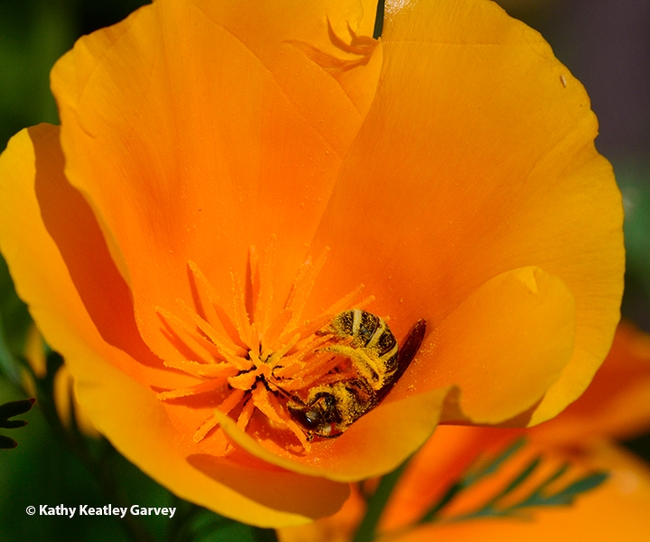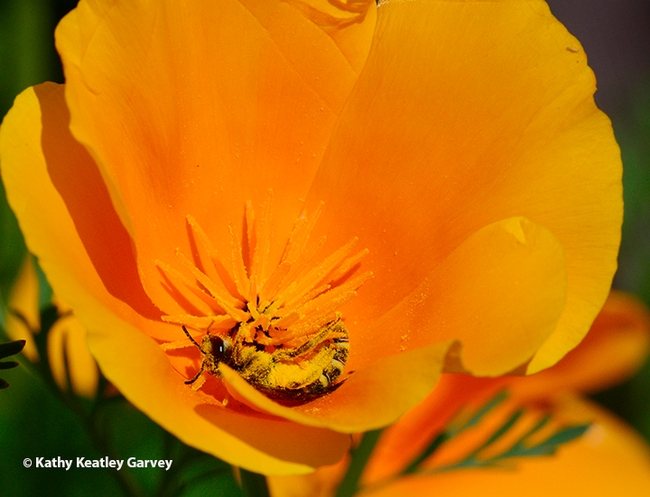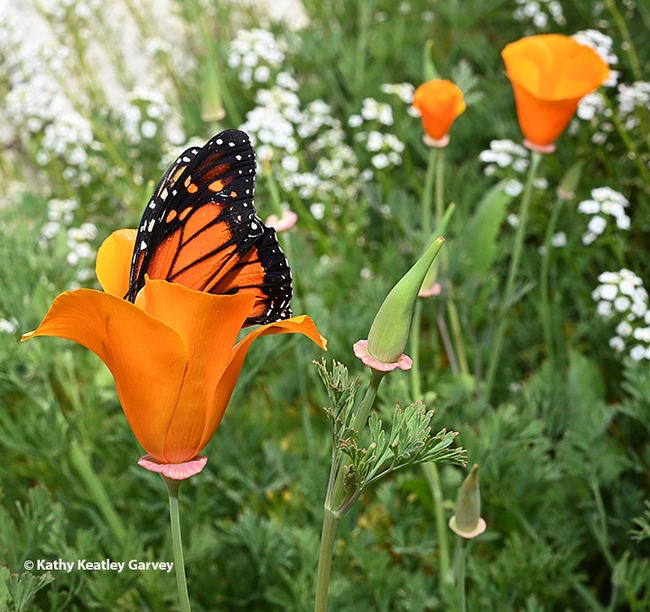- Author: Kathy Keatley Garvey
Look closely at a patch of California golden poppies and you may see a sweat bee (genus Halictus) collecting gold pollen. The pollen basket is on the hind legs but you'll see "gold" also dusting the head and abdomen.
Native bee, commonly known as "halictid bee." Native plant. In fact, the California golden poppy, Eschscholzia californica, is the state flower.
And the rumor that it's "protected" and you'll get arrested if you pick a poppy along a roadside is inaccurate.
The California Department of Fish and Wildlife sets the record straight on its website: "It is often believed that there are laws prohibiting the cutting or damaging of the California poppy because it is the state flower. While there is no law protecting the California poppy specifically, California Penal Code Section 384a(opens in new tab) requires written landowner permission to remove and sell plant material from land that a person does not own, and removing or damaging plants from property that a person does not own without permission may constitute trespass and/or petty theft. However, these laws do not prevent the collection of California poppies on private land by the landowner. California poppies are a beautiful and easy-to-grow addition to your garden, and although you may choose to pick them from your property, they last much longer in the ground!"
Want to learn more about native bees? California has some 1600 species of wild or non-managed bees. Be sure to read California Bees & Blooms: A Guide for Gardeners and Naturalists. It's the work of University of California authors, all with UC Berkeley connections: Gordon Frankie, now professor emeritus, UC Berkeley; Robbin Thorp (1933-2019), UC Davis distinguished emeritus professor who received his doctorate in entomology from UC Berkeley; photographer Rollin Coville, who holds a doctorate in entomology from UC Berkeley, and Barbara Ertter, curator at the UC Berkeley-based University Herbarium and Jepson Herbarium.
The Bohart Museum of Entomology is hosting an open house on bees, both wild and managed, from 1 to 4 p.m., Sunday, May 19 in Room 1124, Academic Surge Building, 455 Crocker Lane. It's free and family free.


- Author: Kathy Keatley Garvey
Monarchs and California golden poppies...Color them orange...Color them bold...Color them beautiful...
And color them natives...
The California golden poppy, Eschscholzia californica, California's state flower, is popping up all over, while monarchs, Danaus plexippus, are winging their way inland from their overwintering sites along the California coast.
The overwintering population in California dropped this year by 30 percent as compared to last year, according to the Xerces Society for Invertebrate Conservation. The stormy weather didn't help.
"The 27th annual Thanksgiving count ran from November 11 through December 3, 2023, totaling 233,394 butterflies across 256 overwintering sites in the western United States," Xerces reports on its website. "This tally is slightly lower than last year's (330,000), yet similar to the 2021 count. The overwintering population of western monarchs remains at approximately 5% of its size in the 1980s."
Overall, habitat loss and increased use of pesticides and herbicides continue to be key factors in the decline of the monarch population.
Interestingly enough, both monarchs and California golden poppies are toxic. "All parts of the (California golden poppy) plant have toxic properties if ingested," according to the State of California Capitol Museum website. And, as we all know, monarchs are toxic. As caterpillars, monarchs sequester or store toxins from milkweed, and those toxins help protect them from predators. The coloring is also a deterrent.
Two natives, toxic, but beautiful...



